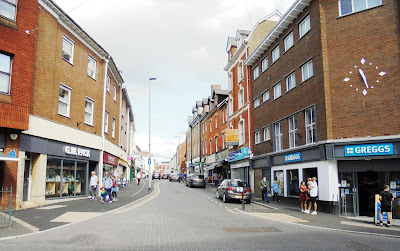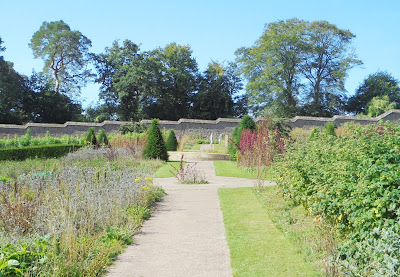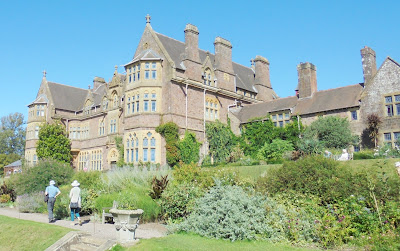Sue and I have not been away for a break since the national lockdown in March. Since then, we should have been on four cruises, but each of them has been cancelled, and as the UK seems to be at the early stages of the second wave of COVID-19 infections – with predictions that it might last until Christmas – we decided to book a self-catering break somewhere in the UK. After looking at what was available in Norfolk, we found that it was proving very popular with other people seeking the same sort of break, and that prices has gone up and availability was very limited.
At this point Sue remembered that back in the late 1990s we had stayed in a self-catering apartment in Tiverton Castle for a week. She checked online … and discovered that it was available. She booked us a four-day stay there, and that is where we have been since Friday 11th September.
Friday 11th September: Tiverton
We had packed the car and left home by midday, and the car’s satnav informed us that we should be at our destination – Tiverton Castle – by 4.30pm. As we were not supposed to arrive until 5.00pm, this suited us as it would mean that we could stop
en route for a break.
The A2 and M25 were busy, and it was no great surprise that we experienced several stop/start holdups as we travelled towards the junction with the M4. It took us ninety minutes to get there, only to discover that our speed along the first twenty or so miles of the M4 was limited to 50mph due to ongoing roadworks. (These are going to turn this section of the M4 into a so-called ‘smart motorway’ … whatever that means!)
By 3.00pm we were well on our way towards the West Country, and decided to stop at Leigh Delamere services for some refreshments and to restore our personal comforts. We were only there for about thirty-five minutes, but during that time, the recommended route had changed drastically. Rather than travelling along the M4 until we reached the junction with the M5, the satnav took us further towards Wales, and then along the M47 towards Avonmouth. This was to avoid a major traffic jam in the Bristol area, and it worked … to a certain extent.
Unfortunately, every other satnav seemed to have given the same instructions, and the traffic jam seemed to have merely moved a bit further along the M5, so that when we joined the motorway, the traffic was barely moving. By this time, it was about 4.30pm, and it was obvious that we were going to be late. In fact, we did not arrive at our destination until 6.15pm.
We were greeted by Mrs Gordon, the wife of the Castle’s owner, and shown around the apartment.
This included a short tour of the areas of the castle that were open to us and a briefing about the changes that were in place due to the COVID-19 pandemic.
By 7.00pm we had unpacked, and after taking a short breather we took a walk into the centre of Tiverton. We found a small pizza restaurant that was open and had space to take us (the Branzino Restaurant), and so we ate there. Having done so – and feeling rather full as a result – we then walked back to the castle, where we rested and watched TV until it was time to go to bed.
Saturday 12th September: Tiverton and Bickleigh
We both slept very soundly, and did not wake up until 8.30am. We took our time to get ready and eat breakfast, and then set out to explore the castle’s grounds.
At 11.30am we walked into the centre of Tiverton for a walk around. Along the way we passed the local parish church, St Peter’s.
From the church, we made our way along Newport Street until we reached the access road leading to the Pannier Market.
Sue and I walked through the Pannier Market …
… and out into Fore Street.
There we indulged in a bit of retail therapy in the local branches of THE WORKS and BOOTS, before walking to the corner of Bampton Street …
… and Gold Street.
Sue and I then made our way down Gold Street as far as the junction with Barrington Street, before retracing our steeps and walking along Bampton Street.
When we reached Newport Street, we turned left and returned to the castle, which is located on Park Hill. Along our route, we passed the end of an interesting street – the aptly named Castle Street – that had an open drainage ditch running up its centre.
Whilst we were out, we had been looking for somewhere to eat lunch, but everywhere seem very crowded or had queues. In the end, we decided to go to the local Morrison’s Supermarket, which has an onsite café. There we were able to each have a toasted cheese and ham sandwich and a drink. The sandwiches were served with a very nice side salad, which turned our snack into a proper meal.
After our late lunch, we drove the five miles to Bickleigh Mill. This is an old watermill that has been converted into a small retail centre selling exclusive or local products as well as a bistro/bar.
We had a walk around the shopping area at the mill, …
… but there was nothing that took our fancy.
We did consider visiting the Devon Railway Centre, which was located next door to the mill, but discovered that due to the pandemic, one had to book in advance. Somewhat deflated, we returned to the castle for afternoon tea and a rest.
For dinner, we went into the centre of Tiverton to find a restaurant that was open and had space. Luckily, we came across the newly-opened Tiverton Steakhouse (formerly the Blue Velvet Bistro) in Bampton Street. They were able to accommodate us, and both we ate very substantial meals that were – by London standards – more than reasonable.
After we had eaten, we took a leisurely stroll back to the castle, where we sat and watched TV until it was time to go to bed.
Sunday 13th September: Topsham and Exmouth
As it was Sunday, Sue and I did not rush to get ready to go out for the day. We finally left the castle just before 11.00am, and drove to Topsham on the River Exe.
We had stayed in The Globe Hotel in Topsham for a week back in the 1990s, and we were interested to see how much it had changed since then. The satnav directed us from Tiverton to the M5, and then south to just outside Exeter. We turned off onto the A376 and used the local Clyst Road to reach Topsham. We parked in the car park behind the local fire station and then set of towards the riverside.
This took us along Fore Street, …
…past The Globe, …
… until we reached the Antique Centre on the quayside.
After looking around the variety of antiques on sale and then at the small boats moored on the River Exe, …
… we strolled up Monmouth Hill, …
… until we reached the Strand, where we sat for a while watching the river.
By this time it was well after midday, and Sue and I decided to go on to Exmouth so that we could see the sea, walk along the seafront, and possibly have lunch.
We drove out of Topsham, and along the A376 towards Exmouth, passing the Royal Marine training establishment at Lympstone along the way. Once we reached Exmouth, we discovered that the car parks nearest the seafront were all full, and in desperation we finally stopped in a parking bay in the centre of the town near The Strand.
We had a stroll around The Strand … and discovered a small car park behind the local council offices in Chapel Hill that had spaces. We were able to park there and walk through Manor Gardens …
… to the seafront.
We had a gentle stroll along the Esplanade, past the memorial to Queen Victoria’s visit to the town.
After several attempts to find somewhere to eat lunch, we ended up in Exmouth’s Pavilion Café, where Sue and I had an excellent meal of fish and chips for lunch. (The fish was fresh, not frozen, and served in a light batter. The chips were also locally-sourced, and were deep fried in fresh oil.)
As we left the café, we could see several large ships moored on the other side of the bay.
These turned out to be cruise liners, the
Queen Mary 2, the
Ventura, the
Azura, and the
Arcadia, who were all moored in the bay between Teignmouth and Torquay.
After spending a couple of hours in Exmouth, we returned home using the A376 and M5, and we back at the castle by a little before 5.00pm. We then spent the rest of the day reading, resting, eating, and watching TV.
Monday 14th September: Knightshayes
As long-term members of the National Trust, we decided to visit the property at Knightshayes. The house itself was not open, but the garden and grounds were. Luckily we had booked our entrance tickets on Sunday (the National Trust was insisting on at least twenty-four hour notice of visits in order to comply with the COVID-19 regulations and advice), and after eating a late breakfast, we set off at 11.00am in order to be there by 11.30am.
It took us less than fifteen minutes to drive from Tiverton to Knightshayes, and we were there well in advance of our booking in time. The car park was relatively empty, and we had no problem finding a place. Sue and I then walked downhill to the Reception Centre, which is located in the old stable block.
Although we were early, we were allowed into the property, and after orientating ourselves, we set off to walk around the large walled garden.
This had originally supplied the main house with fresh fruit and vegetables, as well as flowers, and had its own small vineyard area as well as tomato tunnels and banana plants.
From there we walked over to the main house, looking across the nearby valley as we did.
Though it was not open, we were able to walk along the house's terrace and look at the ornate arched doorway from the house onto the terrace.
Sue and I also walked around the formal garden that is situated just below the terrace, and which gave us an excellent view of the house's frontage, …
… before taking a stroll through some of the parkland around the house. We ended up back at the stable block, …
… which houses the property’s café and shop. After eating sandwiches in the café, we spent some time in the shop, where we bought a few small items to take home with us.
We were back in Tiverton by 2.00pm, and after parking the car at the castle, we went for a walk around the town. It was emptier than we had expected, and most of the stalls in the Pannier Market were closed or in the process of closing. Sue and I did go into several shops in Fore Street, but bought nothing, and we were back at the castle by 3.00pm.
We spent the rest of the afternoon reading and dozing, and at 7.00pm we set off back into town to find somewhere to eat dinner. The Tiverton Steakhouse – which we had eaten in on Sunday evening – was open, and Sue and I both enjoyed a steak dinner. As before, the steak was served on a very hot stone with an accompanying salad, a pile of chips, and a Hollandaise sauce.
Because the restaurant was empty, we ate our meal relatively quickly, and by 8.35pm we were back in our apartment in the castle. Sue and I spent the rest of the evening reading and watching TV, and were in bed by just after 11.00pm.
Tuesday 15th September: Going home
We were awake by 7.00am, and after a quick drink, we began the process of packing. We were ready to leave by 9.30pm, and after hnding back the keys of our apartment to Mrs Godon, Sue and I set off form home.
We paid a visit to the local branch of Morrison’s Supermarket to have breakfast in their café before to filling up the car’s petrol tank at their filling station.
We used a very different route home, going across country to join the A303, and then on to the M3 and M25. Along the way we drove past Stonehenge, sight that I always enjoy seeing. The journey homw took just over four hours, and by just after 3.00pm we had parked outside our house and were unloading our luggage.
Our first break since February was over … and we are already thinking about where to go next!






























































































